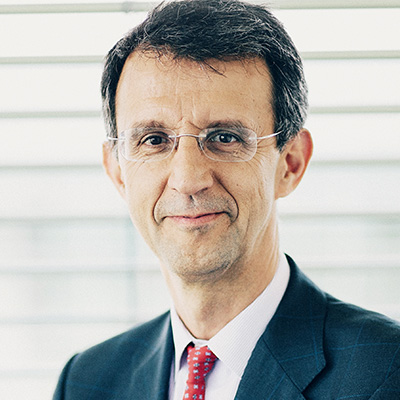Members' interviews
Interview with Diego Pavia CEO of InnoEnergy

4 March 2019

Innovation and forward thinking have long been the cornerstones of the wind energy sector. InnoEnergy will be exhibiting and pushing innovation forward at the WindEurope 2019 Conference & Exhibition in Bilbao.
In advance of this, we bring you the following interview with InnoEnergy’s CEO, Diego Pavia.
Can you tell our readers a little about InnoEnergy?
InnoEnergy is the innovation engine for sustainable energy across Europe, supported by the European Institute of Innovation and Technology.
For us, true sustainability also means an industry that’s commercially viable, endlessly innovative, and highly competitive. We make this possible by helping Europe adopt pioneering new technologies, without risk or complexity.
From mobility to construction – from renewable energy sources to smarter storage solutions – our commercially-attractive technologies are the product of a trusted ecosystem for sustainable energy.
We have supported more than 300 innovative sustainable energy solutions, invested €222 million in innovation projects and attracted nearly €120 million in funding for the start-ups we support – not to mention nearly 960 alumni who have graduated from our Masters and PhD School programmes, many of whom work for prestigious companies such as Tesla, Siemens, Total and Procter & Gamble.
We bring together more than 430 key players from across the energy value chain, from 18 different countries, and with indirect access to 150 million energy consumers.
The result is the proven, landmark innovation needed to reduce energy costs, increase system performance, decrease greenhouse gas emissions, create jobs, and increase competitiveness.
We have been a driving force behind several major European initiatives, including the European Battery Alliance (EBA) made up of more than 250 members from across the battery value chain. Additionally we have also invested in and are supporting Northvolt as Europe’s first battery manufacturing facility.
The clean air debate is also an area we have led, working alongside politicians and policymakers such as Jerzy Buzek, Chair of the European Parliament Industry, Research and Energy Committee and Maroš Šefčovič, Vice President of the European Commission in charge of the Energy Union..
‘Innovation’ is one of the big buzzwords associated with wind energy these days. But for InnoEnergy, ‘innovation’ is not simply a buzzword – it’s the concept at the heart of your entire business model. Tell us, what does ‘innovation’ mean for InnoEnergy?
Since 2011, we have been working towards strengthening the culture of innovation in the sustainable energy field, by accelerating the creation of high-growth companies and bringing innovative products and services to market.
The 300+ high potential innovations we support have brought to life innovative technologies that are meeting the energy challenges of our changing society. Whether it is by reducing greenhouse emissions by contributing to our global demand for energy security, or by creating jobs, these companies are creating impact.
However, sustainable energy innovators are faced with a much longer list of hurdles than many other industries. These include longer time to market, regulatory issues and the need for high capital, all of which make it difficult to achieve market potential.
InnoEnergy is the trusted partner and smart investor in the innovation journey throughout the energy sector. Our mission is to help innovators overcome their challenges. Our position in the industry and our unique collaborative approach helps shorten time to market, mitigate risks, increases the impact of new technologies, and multiply their value.
What are the most exciting developments you have seen in the wind industry in recent years?
This sector has been incredibly dynamic. If one looks back 20 years, the average size of wind turbines were in the range of 600-800 kW whereas today the mainstream is on 3 MW rating – that’s pretty amazing. But then you only need to look at the horizon five years down the line and 4-5 MW class will be dominating onshore and 10-12 MW will be the mainstream for offshore.
And this is only on the technology side. As for business models, the sector has evolved from public grants, to FITs, CFDs, and PPAs as a parallel path to the cost-cutting effort in CAPEX and OPEX.
All in all, this has brought the wind energy sector from a situation in which it was perceived as one of the most expensive technologies run by ‘crazy’ people towards the current status where most of the time the cheapest power generation technology is handled by the biggest industrial companies, major power generation companies, and simultaneously building up a highly qualified workforces.
InnoEnergy will be exhibiting at the WindEurope 2019 Conference & Exhibition this April in Bilbao. What can exhibition attendees expect to find at the InnoEnergy stand?
The focus of our participation this year will be devoted to skills and talent development. This has been identified as a key element that will enable growth and innovation and maintain European leadership in this crucial sector.
Just to recall the winter package targets: it is expected that the renewable energy sector will create 900,000 new jobs and the wind energy sector alone will be the main contributor to this target.
In addition, we will be looking out for new opportunities for our acceleration/incubation programmes and projects in which to invest. Innovation is fundamental to maintaining our leadership.
Looking ahead, what wind energy innovations would you like to see in the coming years? And what role do you see InnoEnergy playing in the future developments of the industry?
Cost reductions, both in OPEX and CAPEX, will remain hot topics for the sector. Other areas will become increasingly important (such as coupling with consumers and other sectors). In this respect, electrical vehicles and their associated business models may affect energy production requirements. This is both important and, at the same time, difficult to assess. This is the same for consumer energy aggregation and other demand/response solutions.
Finally, repowering and recycling are coming and may be quite critical for all stakeholders (society, governments, commercialisation, asset owners and related suppliers).


